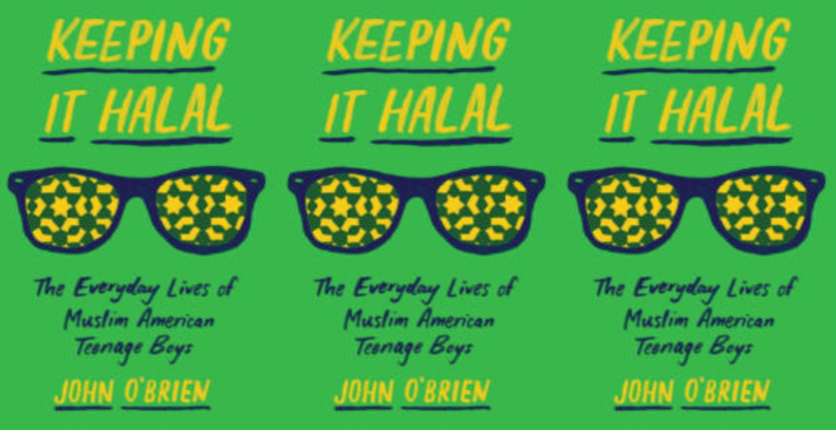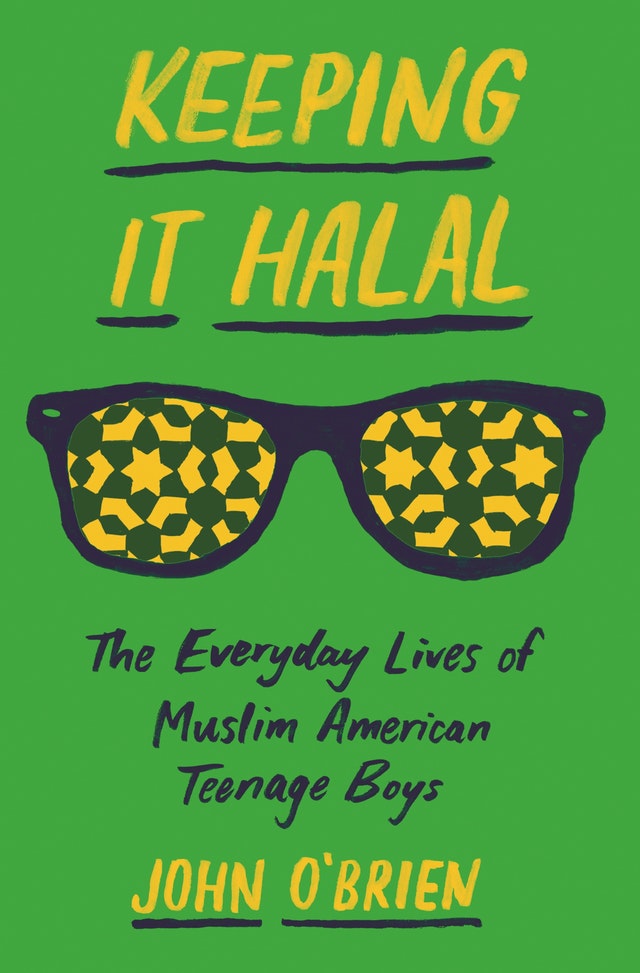
John O’Brien. Keeping It Halal: The Everyday Lives of Muslim American Teenage Boys. Princeton University Press, 2017. ISBN: 9780691168821. 216 pages. $29.95.
Recent scholarship on Muslims in Western societies faces two shortcomings: first, the existing research shows an interest in the issue of gender relations but has heavily focused on Muslim women and femininity. Second, in studying Islam as an identity and institution, scholars have often treated the religion as a fixed set of ideas that is immune to change and whose adherents presumably lack agency to construct and renegotiate their religious identities across time and place. Only a handful of scholars have broken away from these trends, and John O’Brien is one of them. O’Brien has attempted to offer a fresh look at the lives of Muslims from a new perspective in his book, Keeping It Halal: The Everyday Lives of Muslim American Teenage Boys.
The book is based on three-and-a-half years of intensive ethnographic fieldwork studying the lives of seven second-generation immigrant Muslim American teenage boys at a local mosque located in an urban American city. The teenage boys came from various nationalities and ethnic identities – including two Jordanians, two Sudanese, two South Asians, and one Somali – who grew up in the United States.
“The book is based on three-and-a-half years of intensive ethnographic fieldwork studying the lives of seven second-generation immigrant Muslim American teenage boys at a local mosque located in an urban American city. The teenage boys came from various nationalities and ethnic identities – including two Jordanians, two Sudanese, two South Asians, and one Somali – who grew up in the United States.”O’Brien refers to this group as “Legendz,” based on the name of their hip-hop group. Although O’Brien initially intended to study the broader members of the mosque, he later focused on this group of young teenagers because of the unique social position they occupied. What interested him in this group was their ability to strategically manage tensions between the pressures to conform with their community’s Islamic cultural expectations on the one hand, and the general American society’s teenage practices on the other. How to navigate through these conflicting forces was a primary concern for these teenagers and it likewise became the primary focus of O’Brian’s sociological inquiry in this book.
Living as Pious and Cool: Being Religiously Muslim and Culturally American
The book has been written in an interesting story-like narrative. In the preface, O’Brien writes about his experiences of converting to Islam and gaining entry to the field. The preface also gives some contextual information about O’Brien’s research site. The book is divided into six chapters, but the main findings of the research are presented in Chapters 2 through 5, all of which are seasoned with many interesting quotes from O’Brien’s interlocutors. In Chapter 1, he discusses the existing literature on cultural tensions among non-Muslim American teenagers. At the end of this chapter he lays out the book’s central arguments; that is, the lives of Muslim young participants are similar to those of most non-Muslim American teenagers, except that Muslim teenagers’ concerns “were continually intertwined with and sometimes experienced as being at odds with the expectations that surrounded being a ‘good Muslim’ as defined by their community” (20-21). On the one hand, these teenagers were exposed to and comfortable with “hip-hop music, videos, artists, and styles; romantic love and dating; parties with alcohol and drugs; MP3 players and smartphones; cars and motorcycles; skateboarding; Facebook and Twitter; urban gangs; fast food; and basketball” (6). On the other hand, they were required to “meet the religious and social obligations of Muslims as understood within their local context, including praying fives times daily, attending the mosque, fasting for Ramadan, abstaining from premarital dating and sexual intercourse, avoiding consumption of alcohol and drugs, limiting their exposure to potentially profane pop culture, and identifying as Muslims in public” (6). The former set of cultural practices gave them the American adolescent recognition, but they were often considered “as fundamentally incompatible with or in opposition to one another by individuals who were significant to the Legendz – parents, religious leaders, other Muslim youth, friends at school, and, sometimes, themselves” (7). The young Muslim men were, however, strategic in negotiating some of these cultural practices and managing their ‘culturally contested lives’ in similar ways as other non-Muslim American teenagers. Instead of fully engaging in Islamic cultural obligations or in American youth practices, they would navigate through them to present themselves as cool American teenagers and pious Muslim men at the same time.
Chapters 2-5 walk the reader through how the Legendz accomplished such a feat. Each chapter discusses a separate theme, and each theme represents an area of cultural tension. Chapter 2 shows how the youth take advantage of their knowledge of hip-hop music to maintain social status among other Muslim and non-Muslim youth and in the meantime how they incorporate Islamic moral norms into their listening and performing of hip-hop music to win the hearts of their fellow Muslim community members.
“Chapter 2 shows how the youth take advantage of their knowledge of hip-hop music to maintain social status among other Muslim and non-Muslim youth and in the meantime how they incorporate Islamic moral norms into their listening and performing of hip-hop music to win the hearts of their fellow Muslim community members.”For example, while the youth’s parents and mosque leaders associated music with “haram behaviors such as dancing, the use of alcohol or drugs, premarital sex, and the use of profane language” (29), the Muslim youth not only avoided most of these behaviors, but they also applied the moral standards of Islam in their listening, singing and performing of music to demonstrate their conformity to local Islamic expectations (e.g., showing sexual modesty, avoiding un-Islamic terms and gestures, etc.). When interacting with other Muslim and non-Muslim youth outside the mosque, however, they would consciously demonstrate their familiarity with hip hop’s un-Islamic content because it eased their assimilation into the broader society. Chapter 3 heavily focuses on Legendz’s demonstration of autonomy and individualism in performing religious rituals (e.g., praying later than others in the mosque) and in distancing themselves from religious extremism and certain locally normative religious behaviours. For instance, the youth would delay or skip prayer and they would decide to recite “a congregational prayer before and separately from the adults in the mosque’s prayer area” (55). Chapter 4 is about the youth’s involvement in romantic relationships with girls, which was considered inconsistent with the moral standards of premarital Islamic courtship by their local mosque and community. While the youth deviated from local religious teachings on dating and premarital relationships, they would make sure that certain Islamic teachings were present in their day-to-day dating activities.
Chapter 5 discusses how the youth manage to balance their tendency towards autonomy and deviation from the local mosque’s teachings with their desire to remain good Muslims. This chapter is, however, more about the presentation of their Muslim identity in public rather than in their friendship group and local community. Chapter 6, the final chapter of the book, demonstrates a shift in content and writing. There are fewer quotes from the research participants throughout the chapter and, hence, the author’s own voice becomes more visible. He expands on his central arguments and writes about two meetings he held with Legendz, one in-person and one virtual, three and five years after his fieldwork ended respectively. One of O’Brien’s interesting follow-up observations is that the seven Muslim youth still remained religious although dating, physical intimacy, and urban nightlife became more central to their social lives as they grew older. This pattern suggests that Islamic cultural expectations and American youth practices can coexist in one’s identity development but to varying degrees, depending on an individual’s social position and choice of strategies.
Dismissing the ‘Muslim Exceptionalism’ Narrative
Migration and race/ethnicity scholars interested in understanding the relationship between social actors in the micro-level and social institutions at the macro-level will find this empirical work conceptually helpful.
“Migration and race/ethnicity scholars interested in understanding the relationship between social actors in the micro-level and social institutions at the macro-level will find this empirical work conceptually helpful.”O’Brien does a good job of bringing to light the relational nature of the interaction between the two cultures in the minds and hearts of the Muslim youth. In other words, it illuminates how cultural tensions and individual strategies are produced in everyday interactions of American Muslim youth. The book, however, focuses less on the author’s observation of research participants’ interaction with non-Muslim native-born Americans in particular than the local community and mosque members. Moreover, the book tends to treat the research participants only as ‘Muslim teenagers’ and ignores the fact that young Muslim men’s strategies and day-to-day responses may as well include attempts to construct male Muslim identities. Considering that masculinity, as a relational concept, is constructed in relation to femininity, the book could have explored how Muslim youth negotiated cultural tensions to situate their masculinities if O’Brien’s observations focused on Muslim young men’s interactions (i.e. dating, friendships, distancing from presumed feminine practices, etc.) with Muslim and non-Muslim female teenagers more in-depth. O’Brien writes in the preface of the book that he decided to “focus on a nearly exclusively male friendship group” (xix) due to certain Islamic cultural constraints (i.e. gender segregation at the mosque and the issue of mixed gender interaction), but he does not offer any conceptual justifications for it. Targeting this male Muslim population would have been conceptually more meaningful if O’Brien focused on exploring how Muslim young men constructed their male identities in light of the cultural tensions embedded in the three layers of their friendship group, the local Muslim community, and broader society.
“Considering that masculinity, as a relational concept, is constructed in relation to femininity, the book could have explored how Muslim youth negotiated cultural tensions to situate their masculinities if O’Brien’s observations focused on Muslim young men’s interactions (i.e. dating, friendships, distancing from presumed feminine practices, etc.)”
In conclusion, the book is timely and important because it offers a new perspective on Muslim American men as a marginalized immigrant group who are vulnerable to negative stereotypes. The arguments and conclusions correctly contrast with the oversimplified ‘Muslim exceptionalism’ narrative – that all Muslims are the same and that they are different from native-born members of Western host societies and other immigrant groups. It shows that the young Muslim men, in O’Brien’s words, “are constantly working to do what some insist cannot be done: to bring about reconciliations and workable compromises between the cultural expectations of religious Islam and those of American culture” (x).
Sayed Hamid Akbary is a PhD candidate in the department of sociology at the University of Calgary in Canada where he also serves as a sessional instructor. Hamid’s doctoral research explores the intersection of gender and race/ethnicity in Muslim immigrant men’s masculine identity construction and sense of belonging to Canada. As a Fulbright Fellow, he received a master’s degree in sociology from Lehigh University in the United States.


